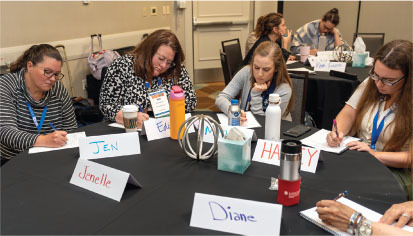March/April 2018
Leading Insight
Find Leadership Potential Where You’re Not Looking
 It’s not uncommon for architecture and engineering firms to target their top-performing employees for coaching through a formal leadership development or mentoring program. Focusing on “high potential” employees isn’t a bad idea, but your firm’s future may benefit from a new outlook on leadership potential.
It’s not uncommon for architecture and engineering firms to target their top-performing employees for coaching through a formal leadership development or mentoring program. Focusing on “high potential” employees isn’t a bad idea, but your firm’s future may benefit from a new outlook on leadership potential.
According to a Development Dimensions International white paper, 65% of organizations have a “high-potential” leadership program, but 68% of these companies revealed that the programs aren’t very effective. Only 43% of organizations report that their critical business roles can be immediately filled by internal candidates.
Why are these high-potential programs failing? The authors point out that too many gatekeepers in organizations use a poor definition of potential, which can cause them to exclude talented individuals from leadership development programs. When firms implement high-potential programs, they focus on a small group of people to address the organization’s greatest challenges. This may lead to impossible expectations for people in this group, some of whom may not be best suited to meet these challenges.
Organizations that want to reform their leadership development programs, and in turn strengthen their leadership bench, will need to start by broadening their definition of potential. They need to realize that while not everyone has the potential or desire to become a firm’s CEO or hold a top management position, there are even more people with untapped talent who can lead in both high- and low-profile situations. Firm leaders, according to the white paper, can start to reform their organizations by taking some of the following actions.
Feed Potential
Firm leaders must realize that potential isn’t the same as capability, and employees with potential need to be groomed to unleash that potential. How can this happen? Increased and targeted development conversations with peers, supervisors, or mentors and the creation of a personal development plan that focuses on leadership. Feeding potential may require providing foundational leadership training to employees in nonleader roles to provide them with transferable skills while providing advanced training and developmental experiences for individuals in formal leadership roles.
Cultivate a Leadership Consciousness
Infuse your firm’s culture with the idea that leadership is not solely the domain of those with leadership titles. Support this message by investing in the entire workforce to help employees realize their leadership potential.
Get People in the Game Earlier
Individuals who go the furthest in their careers are often the ones who have development and growth opportunities early on. Providing early-career leadership opportunities is also an effective way to increase diversity within the leadership population.
Take Small Risks and Test Possibilities
Not all of those with potential will develop to their fullest, while others, given even a small opportunity, will make the most of it and prove worthy of taking on more responsibility. To release the organization’s potential, generate development and growth opportunities for everyone, not just “high potential” employees.
Understand How Context Influences Success
Whether an individual makes strides toward realizing their potential or fails to perform up to it will depend on circumstances beyond their control. An individual operating in an ideal context, perhaps working as part of a highly talented and capable team, will appear to have more potential, while someone in a hostile group or difficult economic conditions may have shown excellent leadership despite producing disappointing results.
Build Transferable Skills and Mental Models
One of the best ways to accelerate leadership capability is to help individuals develop leadership skills they can apply to roles outside their current ones, and which they can build on if moved into another role.
Access the white paper “The Revolutionary Guide to Rethinking Leadership Potential”.


 Volunteering at NSPE is a great opportunity to grow your professional network and connect with other leaders in the field.
Volunteering at NSPE is a great opportunity to grow your professional network and connect with other leaders in the field. The National Society of Professional Engineers (NSPE) encourages you to explore the resources to cast your vote on election day:
The National Society of Professional Engineers (NSPE) encourages you to explore the resources to cast your vote on election day:




